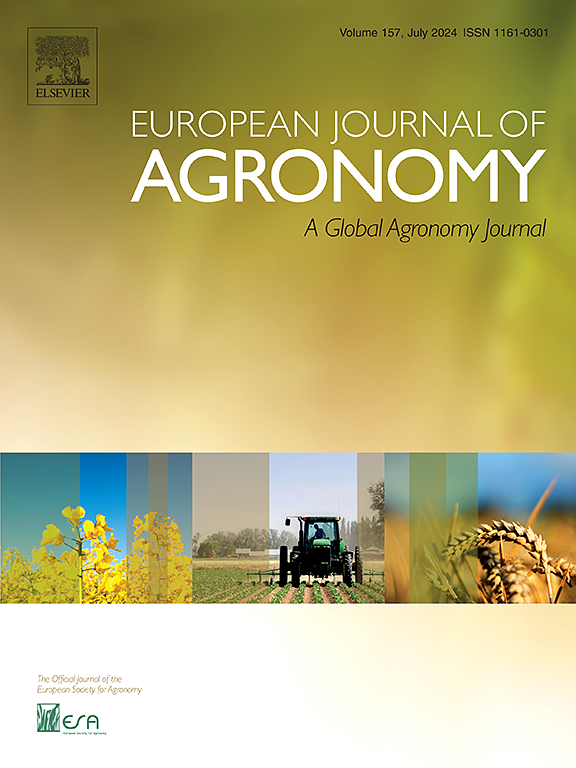利用遥感数据和环境变量预测马铃薯植株含氮量的模型在不同年份和地区的可移植性
IF 4.5
1区 农林科学
Q1 AGRONOMY
引用次数: 0
摘要
由于传统方法耗时、耗力且具有破坏性,使用遥感技术监测作物的氮营养状况正逐渐成为更明智的选择。然而,大多数利用遥感数据的预测模型都是统计模型,而不是机理模型,因此很难在年际和区域尺度上推广。本研究探索了马铃薯植株含氮量(PNC)预测模型的年际和区域可转移性,该模型结合了环境变量(EV,如温度、降水等)和近程高光谱植被指数(VI)。采用了两种方法来融合环境变量和植被指数。第一种是利用多元线性模型和随机森林方法进行多元回归分析,分别将VIs和EVs作为自变量。第二种是分层线性模型(HLM),利用 EVs 动态调整不同实验点的 VIs 和 PNC 之间的关系。预测结果表明:(i) 仅依靠光学 VIs 的传统方法在年际和区域 PNC 预测中表现出有限的准确性和稳定性;(ii) 尽管多元回归方法显著提高了校准集内的模型准确性,但其跨年和跨区域的可扩展性仍不理想;(iii) HLM 方法在跨年和跨区域方面表现出较高的准确性和可扩展性,在验证集中的 R2、RMSE 和 NRMSE 值分别为 0.68%、0.50% 和 19.68%。这些结果证实,使用双层 HLM 方法可以通过 EV 自动调整 VIs 对 PNC 响应的差异,从而提高模型的稳定性。如果能在马铃薯生长周期内持续获取遥感数据和EVs,它将为马铃薯氮素诊断提供一种特别有前途的方法,作为区域施用氮肥的决策工具。本文章由计算机程序翻译,如有差异,请以英文原文为准。
Transferability of models for predicting potato plant nitrogen content from remote sensing data and environmental variables across years and regions
The use of remote sensing technologies to monitor the nitrogen nutrient status of crops is gradually becoming a more sensible choice, as traditional methods are time-consuming, labor-intensive, and destructive. However, most predictive models utilizing remote sensing data are statistical rather than mechanistic, making them difficult to extend at interannual and regional scales. This study explored the interannual and regional transferability of the potato plant nitrogen content (PNC) prediction models, which combined environmental variables (EVs, e.g. temperature, precipitation, etc.) with proximal hyperspectral vegetation indices (VIs). Two methodologies were implemented to fuse EVs and VIs. The first involved a multiple regression analysis utilizing a multivariate linear model and a random forest approach, with VIs and EVs treated as independent variables, respectively. The second, a hierarchical linear model (HLM), employed EVs to dynamically adjust the relationship between VIs and PNC for different experimental sites. The predictive outcomes demonstrated that (i) the conventional method relying solely on optical VIs exhibited limited accuracy and stability in interannual and regional PNC forecasting; (ii) albeit the multivariate regression approach significantly enhanced model accuracy within the calibration set, its scalability across years and regions remained suboptimal; (iii) the HLM method exhibited high precision and scalability across years and regions, with R2, RMSE, and NRMSE values of 0.68, 0.50 %, and 19.68 % in the validation set, respectively. Those findings corroborate that using a two-tier HLM method can automatically adjust for discrepancies in VIs response to PNC through EVs, thereby enhancing the model's stability. Provided that remote sensing data and EVs are sustainably acquired over the potato growth cycle, it will provide a particularly promising approach to potato nitrogen diagnostics as a decision-making tool for regional application of nitrogen fertilizer.
求助全文
通过发布文献求助,成功后即可免费获取论文全文。
去求助
来源期刊

European Journal of Agronomy
农林科学-农艺学
CiteScore
8.30
自引率
7.70%
发文量
187
审稿时长
4.5 months
期刊介绍:
The European Journal of Agronomy, the official journal of the European Society for Agronomy, publishes original research papers reporting experimental and theoretical contributions to field-based agronomy and crop science. The journal will consider research at the field level for agricultural, horticultural and tree crops, that uses comprehensive and explanatory approaches. The EJA covers the following topics:
crop physiology
crop production and management including irrigation, fertilization and soil management
agroclimatology and modelling
plant-soil relationships
crop quality and post-harvest physiology
farming and cropping systems
agroecosystems and the environment
crop-weed interactions and management
organic farming
horticultural crops
papers from the European Society for Agronomy bi-annual meetings
In determining the suitability of submitted articles for publication, particular scrutiny is placed on the degree of novelty and significance of the research and the extent to which it adds to existing knowledge in agronomy.
 求助内容:
求助内容: 应助结果提醒方式:
应助结果提醒方式:


